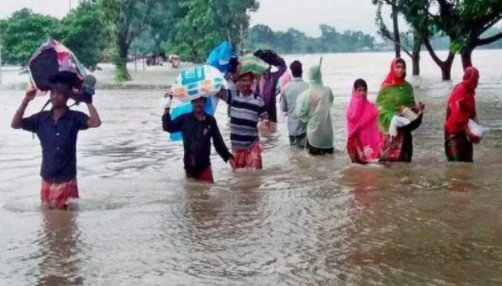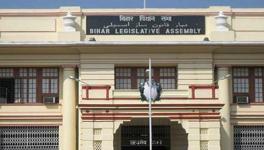Fresh Floods Threaten Thousands in North Bihar Following Heavy Rainfall

Image Courtesy: PTI
Patna: The flood situation in Bihar is again threatening thousands in the northern part of the state following heavy rains from the monsoon which has persistated for the past three days in the state and the catchment area of major rivers in neighbouring Nepal. All the major rivers, including Ganga, Koshi, Bagmati, Gandak, Burhi Gandak, Kamla Balan and Lakhandei are in spate. Authorities have sounded the alert and appealed to people living in low-lying areas near rivers to shift to elevated places.
The sudden rise in water levels resulted in unexpected flood-like situations in areas where flood water had started receding earlier in August or last week – in some cases. However, the recent heavy rains worsened the flood situation and the Water Resources Department (WRD) was forced to release 4.04 lakh cusecs water from the Valmiki Gandak barrage into river Gandak on Friday. It came after a record rainfall of 160.3 mm in West Champaran over 24 hours on Thursday-Friday.All the 36 gates of the barrage were also opened.
As per WRD officials, the Ganga has been flowing above the danger mark at Patna, Hathidah, Bhagalpur and Katihar. Similarly, the Koshi is flowing above the danger mark in Supaul and Saharsa, while residents of Sitamarhi, Sheohar, Muzaffarpur, Samastipur and Darbhanga lie in fear of the Bagmati river. The Burhi Gandak is flowing above the danger mark in Khagaria, Muzaffarpur and Samastpur, the Kamla Balan in Madhubani and Darbhanga, Ghaghra in Siwan, Mahananda in Katihar and Lakhandei in Sitamarhi and Muzaffarpur districts.
According to local reports, flood water entered hundreds of villages and spread to new areas in flood-affected districts of the state over the past 24 hours. In several places, flood water submerged vast low-lying areas and flowed three-to-four feet high on roads, including national highways.
Flooding is not new to Bihar. Not just major rivers, their tributaries, which are mainly monsoon-driven, also flood large areas and inundated village after village, displacing thousands in the process.
Flood water entered Darbhanga for the third time in the last two months. Dozens of villages in Kusheshwar Asthan and Ghanshyampur blocks were affected following the rise in Koshi and Kamla Balan on Saturday.
The swollen Gandak overflowed and flood water entered dozen of villages under Panapur block in Chapra on Saturday. It happened a day after a record quantity of water was released from the barrage into the Gandak. Similarly,dozens of villages inundated in six blocks in Gopalganj and hundreds are facing threat of floods .
The flood situation has worsened in a large part of West Champaran and East Champaran due to heavy rainfall that resulted in rising water levels in the Gandak and its tributaries.
The West and East Champaran and Gopalganj district administration sounded an alert in all vulnerable blocks and directed local authorities to help the villagers to shift to safer places.
Rising water levels in the Koshi has been putting extra pressure on its eastern embankment in Saharsa district. A WRD official said: “The pressure on embankments has increased after the rise in water level of rivers in the past 48 hours.”
Since mid-June, thousands of people, mainly poor, have been forced to live alongside flood water in more than a dozen districts bordering Nepal, as water is yet to recede.
Over the last two and half months the floods destroyed unaccounted thatched and mud houses, caused heavy damage to standing crops and roads as hundreds of villages remain marooned and large tracts remain submerged by flood water. There is little chance of respite from the flood water in the coming days with the IMD forecasting more rains this week and later in September.
Bihar witnessed heavy rainfall with the onset of monsoon this year. Heavy rainfall in the state is normal during July and August, but the eastern state received surplus rainfall in June, just as the monsoon arrived. This resulted in floods in the low-lying areas.
In June 2021, Bihar received 354.3 millimetres (mm) of rainfall — 111% more than the normal for the month. This excess rainfall drove the total precipitation through July 31 to 613.1 mm for the two months — about 19% higher than the normal rainfall for the period.
Weather officials in Patna said the state received 835 millimetres of rainfall from June 1 to August 25, which is nearly 14% above the normal rainfall generally received.
According to a preliminary assessment of crop damage by the agriculture department, more than five lakh hectares of crops, including paddy, maize, sugarcane and vegetables, were destroyed by the floods this year in the state.The swollen rivers inundated and destroyed thousands of acres of crops in 2020 as well.
According to the WRD's website, Bihar is the most flood-affected state in the country, accounting for close to 17.2% of the total flood-prone area in India. Out of 94.16 lakh hectares, 68.80 lakh ha (76% of north Bihar and 73% of south Bihar) is flood-prone. At present, 28 out of 38 districts in the state are flood-prone.
Get the latest reports & analysis with people's perspective on Protests, movements & deep analytical videos, discussions of the current affairs in your Telegram app. Subscribe to NewsClick's Telegram channel & get Real-Time updates on stories, as they get published on our website.





















